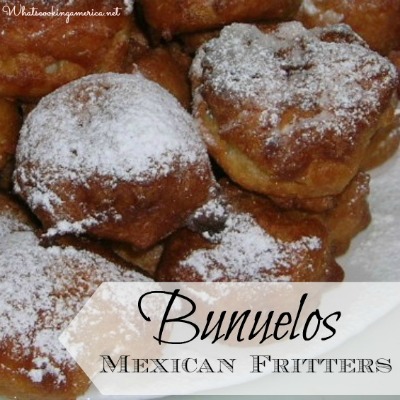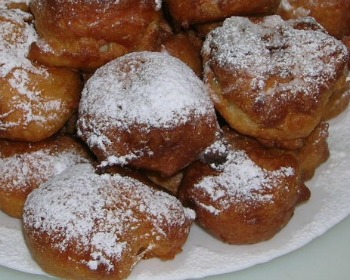Bunuelos are served for numerous festive occasions and celebrations – from Christmas and Thanksgiving, to birthdays and baptisms. Many people of Hispanic heritage believe Bunuelos bring good luck when eaten during the holiday season. They are extremely popular on Christmas among the Mexican community.
What are Bunuelos? They are kind of like a “fritter” and also are like a hot bread that is sort of like a popover, a Mexican Popover. Over the years they have become often confused with other fried breads of the southwest, such as Indian Fry Bread. It should be made known that they are not Sopapillas, and they are not Fry Bread. Each of these three breads is actually very different. Bunuelos are more akin to a doughnut than to a Sopapilla since Sopapillas originated from the Indian Fry Bread of New Mexico’s Native Population.
Restaurants and cookbooks alike, have confused these three breads. For that reason, I want to show all three so the differences, as well as the similarities, can be seen. Learn about Navajo Fry Bread – Indian Tacos and Sopapillas.
This recipe and photos are courtesy of Cynthia Detterick-Pineda of Andrews, TX.
History of Bunuelos:
It is though that Bunuelos originate from Spain. During the Spanish settlement of the Americas, explorers brought the Buñuelo tradition with them. These Bunuelos, or fritters snacks, are consumed throughout Latin America, and are also popular in Colombia, Nicaragua, and Cuba. Although the ingredients vary slightly throughout the different regions, each evolving according to local tastes and customs. Some countries add anise seeds, others put sugar, cinnamon, honey, jam, or cream on them. All Buñuelos have a wheat-based dough.
Many people of Hispanic heritage believe Buñuelos bring good luck when eaten during the holiday season. They are extremely popular on Christmas among the Mexican community,
“Most countries have their version of Bunuelos, or fritters, either sweet or savory, and they are certainly great favorites throughout Spain and Latin America. In many parts of Mexico bunuelos are made of a stiffer dough, which is rolled out thin anywhere up to 12 inches in diameter and then fried crisp and staked up ready for use. In Uruapan…they are broken into small pieces and heated quickly in a thick syrup of piloncillo, the raw sugar of Mexico. These of Veracruz are very much like the churros of Spain, but flavored with anise seeds, and served with a syrup.” – The Cuisines of Mexico, by Diana Kennedy
- 1/4 cup warm water (105 to 110 degrees F.)*
- 1 tablespoons granulated sugar
- 1 package active dry yeast
- 7 tablespoons milk
- 2 tablespoons vegetable shortening
- 1/4 teaspoon salt
- 1 1/2 cup unbleached all-purpose flour
- Vegetable oil (for frying)
-
In a small bowl, stir together the warm water and the sugar. Sprinkle the yeast over this and let it set for about 10 minutes. You will see a froth form on the top it, and you can smell the yeast.
-
In a small saucepan over medium-low heat, heat the milk, shortening, and salt just until the shortening melts. Remove from heat and let the mixture cool down to lukewarm. NOTE: If either the water or milk mix is too hot, it will “kill” the yeast and your dough will not rise.
-
Place the flour into a large mixing bowl and begin to mix in both the yeast and the milk mixtures, stirring briskly to mix in all the ingredients. When the dough becomes to thick to mix with the spoon, turn out onto a lightly floured surface and knead for a minimum of 5 minutes. The dough should be smooth and elastic when pulled and not sticky (it should spring back slightly when you poke a finger into it).
-
Take a small amount of your vegetable oil and place it into a large bowl. Roll the dough ball in the oil, flipping it over and covering the dough ball with a thin coating of the oil. Cover the bowl loosely with a tea towel or plastic wrap. Let the dough rise in a warm place until doubled in size, approximately 1 to 2 hours.
-
NOTE: This recipe can even be made the day before and placed in the refrigerator to rise overnight. Cover the bowl with a plate and make sure there is enough room that the dough doesn’t rise over the edges of the bowl.
-
When dough has risen, punch down the dough, cut it into four (4) equal sections, and allow it to rest for another 10 minutes.
-
While the dough is resting heat your oil to 375 degrees F. (a skillet or electric fryer works best).
-
Divide each dough quarter into three (3) pieces. Pat them into a 4-inch circle, stretching and pressing until a round shape is formed. Carefully place the dough pieces into the hot oil and fry until they puff up and are browned, approximately 1 minute. With a slotted spoon, flip the Bunuelo over and cook for another 1 minute to brown the second side. Remove from the hot oil and drain well.
-
Bunuelos can be kept warm in a 200 degree F. oven for up to 1 hour.
-
They refrigerate well and can be reheated in a 350 degree F. oven for 10 to 15 minutes before serving.
* Anise tea is very often used instead of plain water lending a sweet aroma to the Bunuelos. To make anise tea, place 1 1/2 cup of water in a small saucepan. Bring the water to a boil, add the anise seeds and set aside to cool. Strain and use the amount needed to make dough.
Variation Ideas:
Like doughnuts, there are a variety of ways these can be finished off before serving, or they can be served just as they are.
Sugared Bunuelos:
1/4 cup granulated sugar or powdered (confectioners’) sugar (your choice)
1/2 teaspoon ground cinnamon
Prepare the Buñuelos per the recipe above.
In a large bag, mix the sugar and the cinnamon together. Place the warm buñuelos into the sugar/cinnamon mix (2 or 3 at a time) and close the bag. Shake to coat the bread well. Remove the the bag and enjoy!
Bunuelos in Syrup:
2/3 cup firmly-packed dark brown sugar
1/2 cup sweet wine (such as Madiera or Port)
1/2 cup water
1/4 teaspoon ground cinnamon
Grated peel (zest) of a lemon or orange
1/3 cup raisins
Prepare the Buñuelos per the recipe above.
In a large saucepan over medium heat, bring the brown sugar, wine, water, and cinnamon to a soft boil for 5 minutes or until the mixture begins to thicken. Remove from heat and stir in the grated lemon or orange peel and raisins. Place the warn Buneulos onto a rimmed platter and pour the syrup mixture over them, allowing the syrup to soak in for about 1 minute. Serve.
Filled Bunuelos:
2 tablespoons butter
4 tablespoons firmly-packed brown sugar
3 tablespoons pinons (pine nuts)*
1/4 teaspoon ground cinnamon
1/8 teaspoon ground cloves
* Almonds may be substituted if pine nuts are not available.
Prepare the Bunuelos per the recipe above through forming the dough rounds (see main recipe above).
In a food processor or blender, combine butter, brown sugar, pine nuts, cinnamon, and cloves; blending until smooth. With a rubber spatula, scrape down the sides to make sure all the ingredients are ground completely.
To stuff the Bunuelo dough rounds, take a sharp knife and score the back of each dough round slightly (do not cut through the dough). Spoon 1 teaspoon of the filling mixture slightly to one side of the dough round and fold the dough in half. Using a fork, press all the way around the edges so that a seal is formed.
Fry the stuffed Buñeulos in oil as described in the main recipe: drain and serve.
Categories:
Christmas Dessert Recipes Fried Bread International Regional Foods Mexican Southwest Breads Southwest Desserts Sweet Yeast Breads Thanksgiving



4 Responses to “Bunuelos Recipe and History”
Bill
I was in Nogales Mexico some years ago I came across a donut like pastry that was soft fluffy and not overly sweet. Some had a honey based hard frosting topping and were made on a small flat top of an oven. Never got the name or been able to find them again. I am wondering if those were Bunuelos or something else? Maybe made with honey as the sweatner?
Mauro Trejo
You may have had coyotas. They are made with piloncillo (brown sugar) and are popular in Sonora (the state Nogales is in).
Maggie Unzueta
Wow! This looks incredibly delicious.
a goddam goblin
🙂